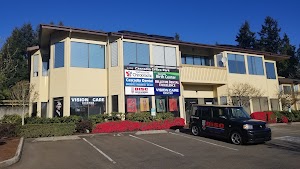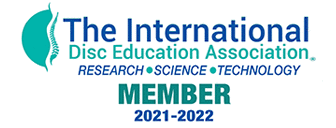SIMPLE PELVIC TRACTION GIVES INCONSISTENT RELIEF TO HERNIATED LUMBAR DISC SUFFERERS
EDWARD L. EYERMAN, MD Journal of Neuroimaging June 1998 A new decompression table system applying fifteen 60 second tractions of just over one half body weight in twenty one-half hour sessions was reported to give good or excellent relief of sciatic and back pain in 86% of 14 patients with herniated discs and 75% of patients with facet joint arthritis.
LONG-TERM EFFECT ANALYSIS OF IDD THERAPY IN LOW BACK PAIN: A RETROSPECTIVE CLINICAL PILOT STUDY
Low back pain is one of the most common problems treated by orthopedic surgeons. Eighty percent of adults will experience significant low back pain sometime during their life. Second to the common cold, problems caused by the lower back are most frequent cause of lost workdays in adults under the age of 45.
RESEARCH SYNOPSIS
1) Bogduk, N,: The Anatomical Basis for Spinal Pain Syndromes. JMPT 6:Nov.Dec1995. There is no scientific basis for the belief muscles are a source of chronic pain. However controlled studies show how common disc and facet pain is accounting for more than 70% of chronic back pain.
THE RESULTS OF THE TREATMENT FOR THESE PATIENTS ARE THE FOLLOWING:
- 1% reported increased pain.
- 7% reported no change.
- 92% reported improvement. Of these, 5% improved 25-50%. 17% improved 50-75%. 70% improved 75-100%.
- On a pain scale of 0-5, the average pain for all before treatment was 4.1; after treatment 1.2- a difference of 71%.
- 71% reported a pain reduction to 0-1 on the 0-5 pain scale.
- Extruded disc patients reported an average 56% reduction of pain and 53% reported pain reduction to 0-1.
- Multiple herniated disc patients reported a 71% reduction of pain and 72% reported pain reduction to 0-1.
- Single herniated disc patients reported a 71% reduction of pain and 73% reported pain reduction to 0-1.
- Degenerative disc disease patients reported a 70% reduction of pain and 72% reported pain reduction to 0-1.
- Facet syndrome patients reported a 72% reduction in pain and 68% reported pain reduction to 0-1.
- Among patients who had reported decreased spinal mobility before treatment, 77% reported improved spinal mobility.
- Among patients who had reported limited activities before treatment, 78% reported improved activities.
- On a scale of 0-3 the average satisfaction with treatment was 2.4, meaning “very satisfied” to “completely satisfied” with their treatment.
The study’s authors concluded that this treatment should be used for everyone with the above diagnoses and for patients that have had previous surgery and are still having pain.
To my knowledge one of the largest available study, thus far, on the efficacy of non-surgical disc decompression was the data compiled by Gose, Naguszewski & Naguszewski published in Volume 20 of the journal, Neurological Research. The data consisted of outcomes for 778 patients from 22 medical centers. These patients had their pain for an average of 40 months. 31 of these patients had previous low back surgery. The treatment consisted of 10-20 treatment sessions. 6 patients were excluded from the study because they improved before 10 treatments.
- 34 of the patients had extruded discs
- 195 had multiple disc herniations
- 382 had single disc herniations
- 47 had degenerative discs without herniations
- 19 had facet (joint) pain
- 31 of these 778 patients had previous low back surgery
RESEARCH SYNOPSIS
| 1) Bogduk, N,: The Anatomical Basis for Spinal Pain Syndromes. JMPT 6:Nov.Dec1995. There is no scientific basis for the belief muscles are a source of chronic pain. However controlled studies show how common disc and facet pain is accounting for more than 70% of chronic back pain.2) Komari H, et al.: The Natural History of Herniated Nucleus with Radiculopathy. Spine 21: 225-229, 1996 77 patients verified on pre-post MRI with signs and symptoms of herniation, underwent non-surgical intervention including pelvic traction. Changes in herniation and good-excellent symptomatic improvements were noted in over 82%. The authors draw the conclusion improving the disc’s contact with the blood supply accounts for healing of herniation.
3) Onel,D et. al.: CT Investigation of the effects of Traction on Lumbar Herniation. Spine 14: 82-90, 1989. 30 patients with lumbar herniations were tractioned in a CT scanner at >50% body weight for ~20 min. Hernia retraction occurred in 70% and good clinical improvements were seen in over 93%. The authors concluded improved blood flow was the source of healing. Additionally they speculated previous studies showing traction doesn’t create negative intradiscal pressures perhaps used too light a force. 4) Saal, JA Saal, JS: Nonoperative Treatment of Herniated Lumbar Disc w/ Radiculopathy. Spine 14 (4): 431-437, 1989. 58 subjects had an inclusive conservative program including traction (when initially shown to reduce leg symptoms). Overall 86% had good-excellent results. 5) Mathews, JA: Dynamic Discography: A Study of Lumbar Traction. Annals of Phys Med, IX (7), 265-279, 1968. 3 patients with a ruptured lumbar disc had contrast medium and radiographic images taken during and after a lumbar traction procedure. The protrusions were shown to lessen considerably with the 30 minute prone traction sessions and a dimpling of the outer annulus suggested a negative intradiscal force was created. 6) Lidstom, A Zachrisson M: PT of the low back pain and sciatica. Scan Joul of Rehab Med, 2: 37-42, 1970. Intermittent supine traction with -+50% body-weight, (10) 20 minute sessions with added exercises showed considerable improvement in over 90% of the 62 patients. 7) Hood, LB Chrissman, D: Intermittent Traction in the Treatment of Rupture Disc Plays Ther 48: 21, 1968. 40 patients with neurological signs were treated with traction on a friction-free table with 55-701bs for 20 minutes. Good-excellent results were seen in 55%. 8) Mathews JA et. al.: Manipulation and traction for Lumbago and Sciatica. Physio Pract 4: 201, 1988. A controlled trial of traction with manipulative techniques. Traction force Applied at ~ 100 lbs for 20 minutes leading to substantial relief in over 85%. 9) Constatoyannis C, et. al.: Intermittent Cervical Traction for Radiculopathy Due to Large-Volume Herniations. JMPT, 25 (3) 2002. Three weeks of the above described traction method to large volume hemiations resulted in complete resolution of symptoms in 4 patients. 10) Shealy N, Leroy P: New Concepts in Back Pain Management. AJPM (1) 20:239241 1998. The application of supine lumbar traction with adherence to several specific characteristics including progression to a peak force and altering the angle of ‘pull’ from 10 degrees (L5-S 1) to 30 degrees (L3) enhanced distraction at specific levels. 11) Gose E, Naguszewski W&R: Vertebral axial Decompression for Pain associated With Herniated and Degenerated Discs or Facet syndrome: an Outcome Study. Neuro Research, (20) 3, 186-190, 1997. A retrospective analysis of over 770 cases, many assumed to be unresponsive to previous therapies showed a 71% good-excellent success rate with ~20 treatments on the prone VAX-D traction device. All patients treated prone with 65-95 lbs. of force 3-5 times per week. 12) Weatherall VF: Comparison of electrical activity in the sacrospinalis musculature during traction in two different positions. J Ortho Sports Phys Ther(8):382-390, 1995. Through the use of EMG electrical activity was shown to be similar in the prone laying position vs. the supine position in a group of patients. 13) Letchuman R, Deusinger RH: Comparison of sacrospinalis myoelectric activity and pain levels in patients undergoing static and intermittent lumbar traction. Spine 18(10): 1361-1365, 1993 This study was used to determine muscular guarding/contraction of Paraspinals with intermittent vs. static traction. Improved comfort noted in the intermittent traction group. 14) Chin YG, Li FB, Huang CD: Biomechanics of traction for lumbar disc prolapse. Chinese Ortho; Jan(l): 40-2, 1994. Intervertebral pressure was recorded before and during traction. 62% of prolapsed discs showed negative pressure prior to traction. 64% reduced IDP with traction and was related to distraction distance. In 19% of prolapsed discs the pressure actually increased, demonstrating the disruption to the hydrostatic mechanism occurring with complete annular damage and prolapse. 15) Nanno M: Effects of intermittent cervical traction on muscle pain. EMG and flowmetric studies on cervical paraspinals. Nippon Med J; Apr;61(2):137-47, 1994. Cervical intermittent traction was shown to be effective in relieving pain, increasing frequency of myoelectric signals and improving blood flow in effected muscles. 16) Chung TS, Lee YJ et ah Reducibility of cervical herniation: evaluation at MRI during cervical traction with a nonmagnetic device. Radiology Dec; 225(3):895900,2002. 29 patients and seven healthy volunteers had intermittent traction while in MR. Substantial increase in vertebral length was seen. Full herniation reduction in 3 and partial in 18 was reported. 17) Dietrich Met al: Non-linear finite element analysis of formation and treatment of disc herniation. Proc Inst Mech Eng; 206(4):225-31, 1992. The author’s analysis shows loads not greater than those occurring in everyday life cause loss of stability of the disc and allow lateral nucleus displacement. The model indicates conservative therapy by traction may result in retraction of hernia by about 40%. 18) Ramos G, Martin Wm: Effects of axial decompression on intradiscal pressure. J Neuro 81: 350-353, 1994. Significant negative pressure (-100mm Hg) was recorded at L4/5 disc in three volunteers as axial traction was administered. Negative pressure was recorded at -50 pounds tension perhaps representing a minimal threshold force. Patients were prone and harnessed. ADDITIONAL REFERENCESMackenzie R: Mechanical diagnosis and therapy for disorders of the low back. In Taylor JR, Twomey LT (Eds.): Physical therapy of the low back. Churchill Livingstone, New York, 2000 p.26 & 143. Kushlich SD, Ulstrom RN, Michael CJ: Tissue origin of low back pain and sciatica. Orthop Clin North Am (22): 181,1991. Nachenson AL, Elfstrom G: Intravital dynamic pressure measurements of Lumbar discs. Scand J Rehabil Med 2 Supp 1:1-40, 1970. Yong, Hing K., Kirkaldy-Willis WH:’ Pathophysiology of degenerated discs of the lumbar spine. Phila. The Ortho Clinics of N. Am. Vol.(14) #3 July 83, p.p. 493504. Bogduk N., Twomey L.: Clinical anatomy of the Lumbar Spine. ChurchillLivingstone New York. 1992. p.p. 68-69 & 151-173 Twomey LT.: Sustained lumbar traction: An experimental study of long spine segments. Spine 1985; (10): 146-149. Judkovich BD.: Lumbar traction therapy-elimination of physical factors that prevent stretch. JAMA 1955; 159. 8. Gose E, Naguszewski L.: Vertebral axial decompression therapy: an outcome study. Neuro Resarch. (20)#3, April 1998. Mathews JA.: Dynamic Discograhy: A study of lumbar traction. Annals of Phy Med, IX (7) 1968, p.p. 265-279. 10. Colachis SC.et al: Effects of intermittent traction on vertebral separation. Arch of Phy Med & Rehab 1972 (50), p.p.251-258. Shealy CN. Borgmeyer V.: Decompression, reduction, stabilization of the Lumbar spine: A cost effective treatment for lumbosacral pain. AJPM 1997, 7(2), 663 -665. Winkle D, et al.: Diagnosis & treatment of the lumbar spine. Aspen: Maryland: 1996 p.p. 303-313. Degenerative disorders of the spine. In: Hochschuler SH, Cotler HB, (Eds.) Rehab of the Spine. Mosby MO. 1993 p.p.464-465 & p.260, Cyriax JH: Illustrated Manual of orthopaedic med, London, Butterworths, 1983 p.p. 30-40. Schiotz E, Cyriax JH: Manipulation, past and present. London, Heinemann, 1975 Kushlich S: Tissue origin of mechanical low back pain and sciatica. In: Hochschuler SH, Cotler HB, (Eds.) Rehab of the Spine. Mosby, MO. 1993 p.p.595-599. Natural history of the lumbar spine. In Taylor JR, Twomey LT,(Eds):Physical Therapy of the Low Back, Churchill Livingstone, New York, 2000, p.p 25-26 & 43-51. Onel D et al. Computed tomographic investigation of the effects of traction on lumbar disc herniations. Spine 1989; 14(1):82-9 Hides J, Stokes, M, et al: Evidence of lumbar multifidus wasting ipsilateral to symptoms in patients with low back pain. Spine 1995, 19(2): p. 165 Anderson DBJ, Nachemson, AL. Intervertebral disc pressures during traction. Scand J of Rehab Supple 1983; (9):88-91. Colachis S, Strom J: Cervical traction. Arch Phys Med 1965 (64):815. Braaf MM, Rosner S. Recent concepts in treatment of headache. Headache, (5):3844 1965. Cyriax J: The treatment of lumbar disc lesions. British Medl Jour Dec.23 14341438. Breig A, Troup J: Biomechanical considerations in the straight leg raise test. Spine 1979; (4):242. Mazion JM, Haynes LM: Mazion’s illustrated reference of orto/neuro/physio diagnostic techniques. Casa Grande, Mazion publisher, 4th ed, 1980 Greenstein GM: Clinical assessment of neurological disorders. St. louis, Mosbyyear book, Inc. 1995. Weber H: The natural history of disc herniation and the influence of intervention. Spine 1994 (19): p.p. 2234-2238. Saal JA, Saal JS: The non-operative treatment of HNP with radiculopathy: an outcome study. Spine 1989 (14): p.p. 431-437. Komori H, Shinomiya K, et al., The natural history of HNP with radiculopathy. Spine (21): 225-229, 1996. 34. Quain MB, Tecklin JS,: Lumbar traction: it’s effect on respiration. Phys Ther 1985; 65 (9): 1343-6. Gillstrom P, Erickson K,: CT exam of influence of autotraction on herniation of lumbar disc. Arch Orthop Trauma Surg 1985; 104(5):289-93. Beurskens AJ et al: Efficacy of traction for non-specific back pain. Spine 1997 Dec 1 ;(23): 2756-62. Laban MM et al: Intermittant cervical traction: a progenitor of lumbar radicular pain. Arch Phys Med Rehab 1992 Mar;73 (3):295-6. Pellecchia GL: Lumbar traction: a review of the liturature. J Orthop Sports Phys Ther 1994 Nov:20 (5): 262-7. Austin R: Lumbar traction a valid option. Aust J Physio 1998; 44 (4):280. Constantoyannis C, et al: Intermittent cervical traction for radiculopathy due to large-volume herniated discs. JMPT 2002 Mar; 25 (3). Adams M, Bogduk Net al: Biomechanics of back pain. Churchill Livingstone NY, 2002: p,p 163-167 Grieve G: Mobilization of the spine. Churchill Livingstone NY, 1991: p.p 273283. Martin M, Ramos G: Effects of vertebral axial decompression on intradiscal pressure. J Neur 81: 350-353, 1994. Richardson C, Jull Get al: Therapeutic exercises for spinal segmental stabilization in low back pain. Churchill Livingstone NY, 1999. Dullerud R, Nakstad P: CT changes after conservative treatment for lumbar disc herniation. Acta Radiol Sept;35(3):415-9, 1994. Quain MB, Tecklin JS: Lumbar traction: its effect on respiration. Phys Ther Sept;65 (9):1343-6, 1985. Mcgill S: Low back disorders (evidence-based prevention and rehabilitation). Human Kinetics, 2002. Hseuh TC, Ju MS: Evaluation of the pulling angle and force on intermittent cervical traction. JFMed Assoc 1991 Dec;90(12): 1234-9 Saal JS, Saal JA: Nonoperative management of herniated cervical IVD with radiculopathy. Spine 1996 Aug 15;21(16): 1877-83. Weatherall VF: Comparison of electrical activity in the sacrospinalis musculature during traction in two different positions. J Ortop Sports Phys Ther 1995;(8): 382390. Letchuman R, Deusinger RH: Comparison of sacrospinalis myoelectric activity and pain levels in patients undergoing static and intermittent lumbar traction. Spine 1993;18(10): 1361-1365 Additional Decompression Therapy Research Studies |
| Clinical studies have shown Decompression Therapy to be extremely effective in treating back pain. In a recent study published in Orthopedic Technology Review Decompression Therapy was shown to be 86% effective in treating hemiated and degenerative discs. Not only that, but another study published in Anesthesiology News showed that after 4 years over 91 % remained pain free.OTHER STUDIES THAT SHOW JUST HOW EFFECTIVE DECOMPRESSION THERAPY IS
In the Journal of Neurological Research VOL 20, NO 4, April 1998 the researchers stated: “We consider decompression therapy to be a primary treatment modality for low back pain associated with lumbar disc herniation at single or multiple levels, degenerative disc disease, facet arthropathy, and decreased spine mobility. Physiology (pain and mobility) and pathology correlate imprecisely. We believe that post-surgical patients with persistent pain or ‘Failed Back Syndrome’ should not be considered candidates for further surgery until a reasonable trial of decompression has been tried.” In the Journal of Neurological Research VOL 23, NO 7, October 2001 the researchers stated: “For any given patient with low back and referred leg pain, we cannot predict with certainty which cause has assumed primacy. Therefore surgery, by being directed at root decompression at the site of the hemiation alone, may not be effective if secondary causes of pain have become predominant. Decompression therapy, however, addresses both primary and secondary causes of low back and referred leg pain. We thus submit that Decompression therapy should be considered first, before the patient undergoes a surgical procedure which permanently alters the anatomy and function of the affected lumbar spine segment.” In that same Volume of the Journal of Neuroloaical Research the Senior Lecturer in Orthopedics at Sydney University stated “Successful reduction of intradiscal pressures with decompression therapy represents a technological advance in lumbar spinal treatment and is likely to affect both the biomechanical and biochemical causes of discogenic pain. |


















